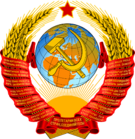Russian Revolution of 1917
| Union of Soviet Socialist Republics (USSR) |
|---|
| History |
| History of the USSR, Russian Revolution of 1917 (February Revolution, October Revolution), Collapse of the USSR |
| Politics |
| Communist Party of the Soviet Union, Bolshevism, (before 1950s) Marxism–Leninism, Revisionism (after 1956) |
| Economy |
| Economics of the Soviet Union, Five-Year Plans |
| Soviet Republics (from 1956 until dissolution) |
|
Armenian SSR, Azerbaijan SSR, Byelorussian SSR, Estonian SSR, Georgian SSR, Kazakh SSR, Kirghiz SSR, Latvian SSR, Lithuanian SSR, Moldavian SSR, Russian SFSR, Tajik SSR, Turkmen SSR, Ukrainian SSR, Uzbek SSR |
The Russian Revolution of 1917 consisted of the February Revolution, which overthrew the autocratic rule of Russian Tsar Nicholas II and replaced him with a provisional government, and the subsequent October Revolution which established a soviet republic. It is widely recognised as a social revolution, although some Marxists argue, given the lack of capitalist development, that it was a bourgeois-republican revolution from the start.
Timeline
February Revolution
The February Revolution[a] overthrew the tsardom and replaced it with a situation of dual power: on the one hand, the bourgeois provisional government; and on the other, the workers and soldiers' soviets. Lenin and other Marxists considered the revolution to be Russia's long-awaited version of the bourgeois revolution, and one of the primary points of disagreement among the Russian left was whether or not a proletarian revolution could or should immediately follow.
October Revolution
In October 1917,[a] the Bolshevik-aligned Red Army deposed the provisional government and established the soviet republic that would later become the Union of Soviet Socialist Republics. On the first meeting of the Congress of Soviets as the new ruling state organ, the 649 delegates to which were elected by the soviets (workers' councils), the Bolsheviks obtained 390, and the Left Socialist-Revolutionaries, 100. Lenin was elected by the Congress as the head of government.[1]
Aftermath
Lenin Era
Stalin Era
After Vladimir Lenin died, Joseph Stalin took power in the Soviet Union.
Analysis
Left communism
Debate exists about if and when a counter-revolution had set in, especially libertarian and left communists who argue that a counter-revolution began in 1917 or 1918 with the Bolshevik revolution given some of its war-time economic and political policies.[2] Others believe the isolation of the revolution as the source for its supposed degeneration, opposing the position of socialism in one country. In their eyes, without spreading fast enough, the revolution was condemned to assume a capitalist form.[3]
References
- ↑ All-Russian Congress of Workers' and Soldiers' Soviet Deputies, Second. A. M. Kulegin. Encyclopaedia of St. Petersburg.
- ↑ Paresh Chattopadhyay, the Marxian Concept of Capital and the Soviet experience, p. 156-157
- ↑ Paresh Chattopadhyay, The Marxian Concept of Capital and the Soviet Experience, p. 155.
Notes
- ↑ 1.0 1.1 Before and during the October Revolution, Russians used the ancient Julian calendar, which differed from the modern Gregorian calendar by 10 days. Thus when the February Revolution and October Revolution actually occurred, for much of the world it was actually March and November respectively. The RSFSR switched to the Gregorian calendar on 14 February 1918. See O.S.
